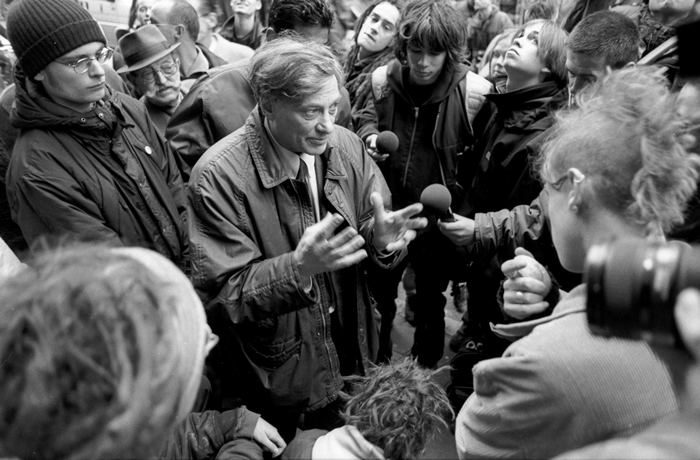Art at the edge
The Flemish curator Jan Hoet died February 27 in a Ghent hospital at the age of 77. Jan Hoet was a flamboyant and charismatic figure who shook up the Belgian art world in the summer of 1986 with the exhibition Chambres d’Amis in which 51 artists including Daniel Buren and Joseph Beuys exhibited works in private homes in Ghent. He went on to create Ghent’s contemporary art museum S.M.A.K. which opened in 1999 with a boxing match.

Jan Hoet as champion; Photo Dirk Pauwels
Jan Hoet curated DOCUMENTA IX in Kassel in 1992. In an article in The Low Countries, the art critic Ludo Bekkers described Hoet’s unique way of working with artists. “Hoet’s greatest merit was that he carried out long and personal preparatory work with all the participants so that they executed work in situ and often surpassed themselves.”
Documenta IX by Ludo Bekkers, 1992
The large international exhibition DOCUMENTA IX, which was held in Kassel (Germany) for the ninth time in 1992, was in many ways remarkable. The eighth exhibition in 1987 had proved problematic right from the outset because the Documenta Board had difficulty agreeing upon the appointment of an artistic director (it was eventually the German Manfred Schneckenburger), and it seems that the exhibition also left behind it a rather unsatisfactory impression. With a deficit of 910,000 dm, the question was finally raised as to whether this reputable enterprise still had a future.

Installation by Joseph Kosuth at Chambres d’Amis 1986
However, contrary to all expectations, there was a ninth event in 1992, and Jan Hoet (1935-), the Flemish Director of the Museum of Contemporary Art in Ghent, was appointed its artistic director. Jan Hoet was already known internationally on account of the much talked-about exhibitions he had organised in Ghent, and his Chambres d’Amis in particular. The Chambres d’Amis was an exhibition of contemporary art which invited Belgian and foreign artists to produce works of art in about thirty private homes. After his appointment to Documenta, this flamboyant and charismatic figure became known internationally as an art promoter who went to work in a distinctly idiosyncratic way. He organised the so-called ‘art marathons’ for the media in Ghent and Weimar, surprising the press and art enthusiasts by showing hundreds of slides of works of art which he had seen during his many exploratory trips all over the world and from which he was to draw up a shortlist. In actual fact, he disclosed nothing of his concept and that aroused considerable annoyance, especially in Germany where they were already suspicious of Hoet because he was not a German. Anyway, the form this particular Documenta would take remained a publicly open question right up until the day of the opening in June 1992.
[widgetkit id=14208]
It soon became clear, however, that Jan Hoet had not gone to work in an impromptu fashion, as had been feared. His ideas created confusion, but behind them lay a sound concept, and while that concept may have been very subjective, it was exciting nonetheless. He broke new ground by selecting ten artists from his own country, and it proved a successful choice. In addition, he had looked for participants in countries belonging to the former Eastern Bloc and he had looked beyond Europe to places like Cuba, Brazil, Chile, Australia, Argentina, the Philippines, Senegal and Korea, countries from which we had seen little in the way of contemporary art until then. In the United States he went for artists who were not in the mainstream, like the Cherokee Jimmie Durham, who was received as a revelation. Of course, well-established artists were not ignored, but Hoet’s greatest merit was that he carried out long and personal preparatory work with all these participants so that they executed new works in situ and often surpassed themselves.

Jan Hoet in the crowd; Photo Dirk Pauwels
All these factors contributed to the overwhelming success of DOCUMENTA IX. Typical art enthusiasts were frequently heard to comment that they had seen exciting art again, while the critiques in the international press – with some exceptions – were positive. The practical results could also be evaluated: during the one hundred days the exhibition was open, there were 609,235 paying visitors, 27% more than on the previous occasion. Despite the fact that the outgoings had never been so high and the exhibition area was larger than ever, this time no financial loss was incurred.
All in all, the outcome was favourable both artistically and financially, and signified a further triumph for Jan Hoet, whose Documenta proved that great achievements can also come from a small country.

